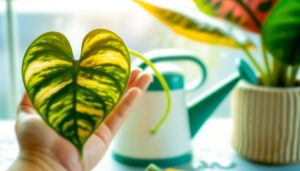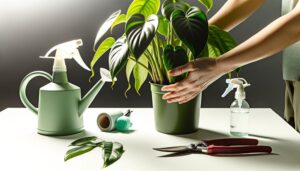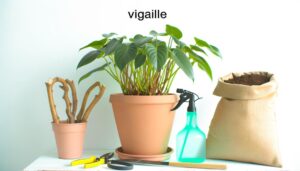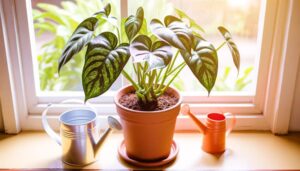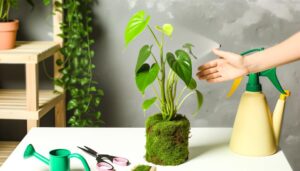Yellow Philodendron Care
Yellow Philodendrons benefit from bright, indirect light, an ideal temperature range of 65–80°F, and relative humidity of 60-80%. They require well-drained soil, sufficient fertilization, and moderate watering; make sure the top inch of soil dries between watering to prevent root rot.
Maintain a good light balance and monitor for nutrient deficiencies to prevent yellow leaves. Regular pruning and strategic repotting promote healthy growth.
Common pests such as mealybugs, aphids, and spider mites should be managed appropriately. A thorough understanding of your specific variant, whether 'Lemon Lime', 'Golden Goddess', or another, contributes to successful care.
Explore further for an in-depth look into their specific needs.

Key Takeaways
- Yellow Philodendrons thrive in bright, indirect light and require high humidity levels of 40-60% indoors.
- They should be watered when the top inch of soil is dry, avoiding over-watering and under-watering.
- To prevent yellow leaves, maintain a balance of light and monitor for nutrient deficiency with regular soil testing.
- Ensure good drainage by choosing a pot with ample drainage holes and using well-draining soil to prevent root rot.
- Manage common pests like mealybugs and aphids with insecticidal soap or neem oil, and promptly remove any infected leaves.
Understanding Yellow Philodendron Varieties

In the field of gardening, understanding the different varieties of Yellow Philodendron is essential for the best care and cultivation.
Known for their vibrant, yellowish-green foliage, these tropical perennials include species like the Philodendron hederaceum 'Lemon Lime' and Philodendron 'Golden Goddess'. Each variant retains unique growth patterns, leaf shapes, and care requirements.
For instance, 'Lemon Lime' exhibits heart-shaped leaves with a luminous quality, thriving in conditions of moderate light and humidity, whereas 'Golden Goddess' presents with elongated, pointed leaves, requiring bright, filtered light to maintain its golden hue.
An in-depth understanding of these varietal distinctions enables gardeners to create ideal environments for plant growth, and execute informed care strategies, hence nurturing these exquisite specimens to their fullest potential.
Ideal Indoor Placement for Philodendrons
Determining the ideal indoor placement for Yellow Philodendrons is an essential aspect of their successful cultivation, as these tropical perennials thrive best under specific light and humidity conditions. Yellow Philodendrons prefer bright, indirect light. Placement near east or north-facing windows allows for ample light without the risk of leaf burn. Additionally, maintaining indoor humidity levels around 40-60% mimics their natural tropical environment, promoting lush growth.
| Ideal Indoor Placement | Explanation |
|---|---|
| Near East-facing windows | Allows moderate, indirect light |
| Near North-facing windows | Provides gentle, indirect light |
| Away from South-facing windows | Prevents overexposure to harsh sunlight |
| Away from direct heat sources | Prevents drying out and maintains humidity |
| In rooms with humidity around 40-60% | Simulates natural tropical conditions |
Outdoor Yellow Philodendron Care
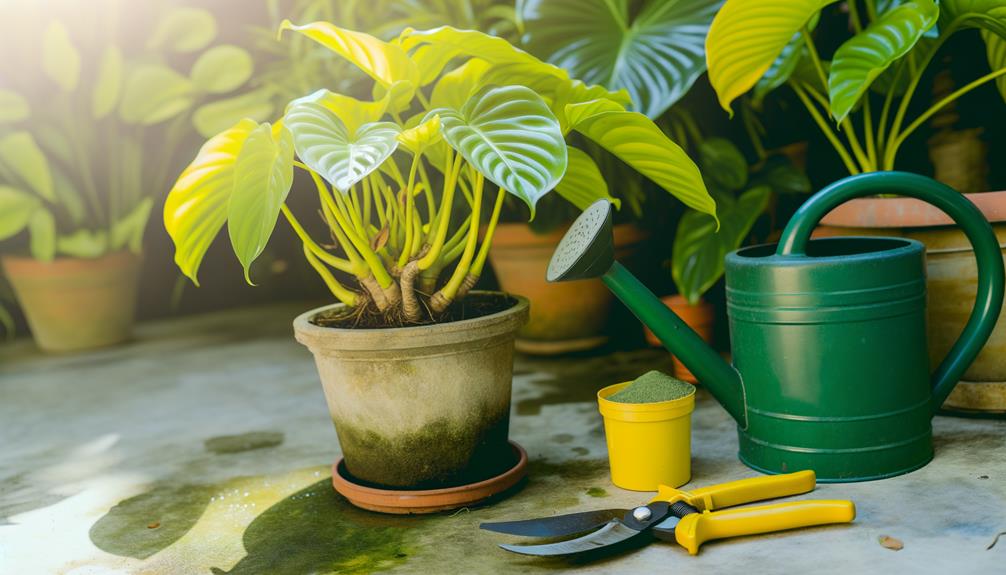
Cultivating yellow philodendrons outdoors requires a nuanced understanding of their environmental preferences, watering needs, and preventive measures to avoid yellowing leaves.
The ideal outdoor conditions for these plants will be examined first, taking into account factors such as light, temperature, and soil type.
We will then address the specifics of proper watering techniques, and conclude with strategies to prevent the development of yellow leaves, a common issue in outdoor yellow philodendrons.
Ideal Outdoor Conditions
Mastering the art of outdoor yellow philodendron care necessitates an understanding of the ideal environmental conditions conducive to its growth and importance. These tropical plants flourish in environments with ample indirect sunlight. Prolonged exposure to direct sunlight can cause leaf burn and discoloration.
Temperature-wise, yellow philodendrons thrive in conditions between 65°F to 80°F. Extreme weather conditions, particularly frost or temperatures below 55°F, can be detrimental, causing irreversible damage to the plant. Humidity is another key factor, with these plants preferring a highly humid environment, similar to their tropical origins.
Lastly, they require well-drained soil, rich in organic matter. High-quality, loamy soil provides a balance of drainage and moisture retention. Adhering to these conditions will result in a vibrant, healthy yellow philodendron.
Proper Watering Techniques
Understanding the correct watering techniques is a key part of maintaining outdoor yellow philodendrons, as these tropical plants have specific hydration needs that can greatly influence their overall health and strength.
- Frequency: Water your yellow philodendron once the top inch of soil becomes dry, but don't let it go completely dry. Over-watering or under-watering can lead to detrimental conditions.
- Method: Use a watering can with a long spout to ensure water reaches the root zone. Avoid wetting the leaves to prevent fungal diseases.
- Water Quality: Softened water can contain salts harmful to philodendrons. Opt for rainwater or distilled water when possible.
Implementing these strategies will enable you to provide the best hydration conditions for your yellow philodendron, contributing to their vibrant growth and longevity.
Preventing Yellow Leaves
While adequate watering practices play a significant role in your yellow philodendron's health, another key aspect to keep in mind is the prevention of leaf yellowing, a common issue faced in outdoor care.
To prevent this, make sure the plant is receiving an appropriate balance of light; too much can cause leaf burn, while too little can lead to pale leaves. Additionally, monitor your plant for signs of nutrient deficiency, as insufficient iron or magnesium can cause leaf yellowing. Regular soil testing can help maintain the best nutrient levels.
Watering Your Yellow Philodendron
Maintaining the optimal hydration for your Yellow Philodendron requires a delicate balance of regular watering and mindful observation of the plant's condition. Overwatering or underwatering can lead to detrimental health effects, such as root rot or wilting.
Here are three key guiding principles to effectively water your Yellow Philodendron:
- Check the Soil Moisture:
Before watering, assess the top inch of the soil. If it's dry, your plant needs water. If it's still damp, wait a bit longer.
- Water Thoroughly:
When watering, do so until water runs out of the drainage holes. This guarantees the roots are adequately soaked.
- Avoid Standing Water:
Never let your plant sit in water. Empty the drainage tray immediately after watering to prevent root rot.
Proper Soil for Healthy Growth

The choice of soil type, the pH level of the soil, and the soil's ability to drain efficiently are all critical factors in the healthy growth of a Yellow Philodendron.
A fitting soil type facilitates the best absorption of nutrients, while the correct soil pH guarantees that the plant's roots can easily access these nutrients.
Moreover, good drainage prevents the harmful effects of waterlogging, such as root rot, which can compromise the plant's health.
Choosing Ideal Soil Type
For peak health and vibrant growth of your yellow philodendron, the selection of the right soil type cannot be emphasized enough. This tropical plant thrives in well-draining soil that retains appropriate moisture without becoming waterlogged.
Here are three types of soil to contemplate:
- Peat-based Mix: Peat moss mixed with perlite for drainage is a popular choice. This mix retains moisture and nutrients but is light and airy, allowing the roots to breathe.
- Sphagnum Moss: This organic material is excellent for water retention while maintaining good aeration.
- Coir-based Mix: A sustainable alternative to peat, coir (coconut fiber) retains water efficiently and is pH neutral.
These soil types offer the correct balance of moisture retention and drainage, promoting robust root development and vibrant foliage in your yellow philodendron.
Importance of Soil Ph
Understanding the soil pH level's role is crucial in ensuring the healthy growth of your yellow philodendron. It directly influences nutrient availability and, consequently, the overall plant health. The optimum pH for philodendrons typically ranges between 5.0 and 6.0, leaning towards slight acidity. At this level, essential nutrients like nitrogen, phosphorus, and potassium are readily available for absorption by the plant roots.
If the pH is too low or high, it can lock these nutrients in the soil, causing deficiency symptoms in the plant. Regular soil pH testing can help monitor this balance. If adjustments are necessary, organic matter or pH adjusters can be added to the soil.
Understanding and maintaining the correct soil pH is therefore a crucial aspect of caring for your yellow philodendron.
Ensuring Good Drainage
Beyond maintaining the suitable soil pH, it's equally important to ensure good drainage for the healthy growth of your yellow philodendron. This guarantees the roots are not overwatered, which can lead to root rot, a common issue that can be fatal to your plant.
For peak drainage:
- Pot Selection: Choose a pot with ample drainage holes. This allows excess water to easily escape, preventing water from pooling at the bottom.
- Soil Composition: Opt for a well-draining soil, preferably a mix of peat moss and perlite.
- Watering Technique: Water thoroughly, but infrequently. Allow the top inch of soil to dry out between watering.
Proper drainage is crucial to the survival and vibrant health of your yellow philodendron.
Yellow Philodendron Light Requirements
An important aspect of yellow Philodendron care revolves around its light needs, with best growth typically achieved in moderate to bright, indirect sunlight. Deep understanding of photobiology reveals that this tropical plant, native to rainforests, has evolved under the shelter of larger canopy trees. Hence, it thrives in dappled light conditions.
Direct sunlight, particularly the harsh afternoon rays, can cause photoinhibition, leading to chlorosis or yellowing of leaves. Moreover, insufficient light can result in etiolation, where the plant grows leggy with small, sparse leaves.
Therefore, a balance is vital. East or North facing windows are ideal. Alternatively, artificial grow lights can be used to supplement natural light, especially in indoor settings. These provide the full spectrum of light, enabling healthy photosynthesis and top-notch growth.
Temperature and Humidity Needs
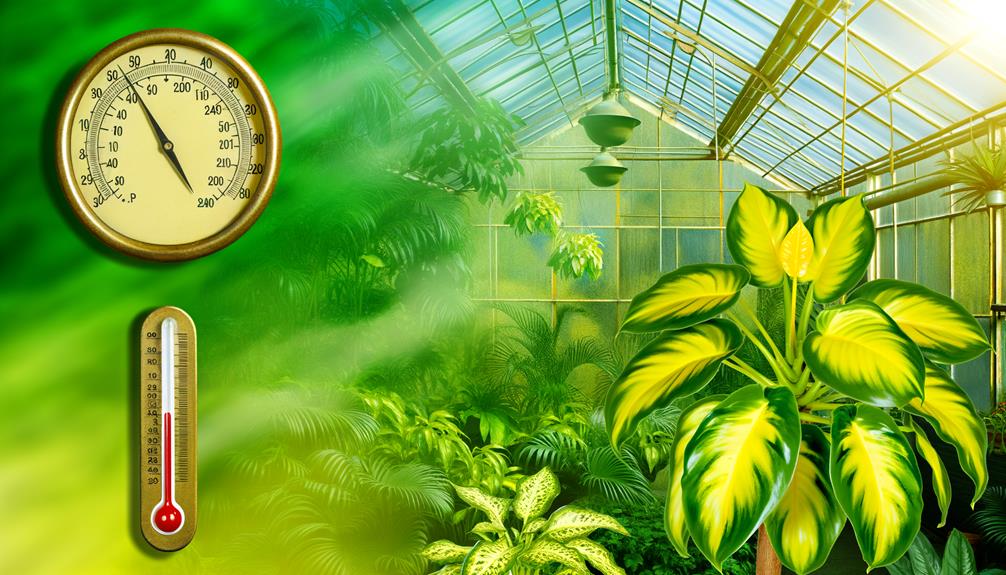
Exploring the nuances of temperature and humidity is crucial for best yellow Philodendron care, as these tropical plants have specific requirements for their environmental conditions to stimulate growth and maintain health.
- Temperature: Yellow Philodendrons typically thrive in temperatures between 65-80°F (18-27°C). Exposing the plant to temperatures below 55°F (12°C) may lead to slowed growth and potential harm.
- Humidity: These plants flourish in high humidity environments, resembling their native tropical habitats. Aim to keep humidity levels around 60-80% for optimal outcomes.
- Fluctuations: Avoid sudden temperature or humidity changes. Consistency is key in maintaining the plant's well-being and vigor.
Fertilizing Your Yellow Philodendron
In addition to maintaining the appropriate temperature and humidity levels, providing adequate fertilization is another significant factor in the successful care of your Yellow Philodendron. Proper fertilization helps in promoting vibrant foliage and robust growth in these tropical plants.
Here is a table with a recommended fertilizing schedule and the ideal nutrient composition:
| Month | Fertilizer Composition | Frequency |
|---|---|---|
| March – August | High in Nitrogen (N), Phosphorus (P), and Potassium (K) | Once a month |
| September – February | Lower in N, P, K | Once every two months |
Always remember to water your plant thoroughly before and after fertilizing to prevent root burn. Also, avoid over-fertilizing as it can lead to excess salts build-up, causing leaf burn. Adjust the regimen based on the plant's health and growth rate.
Pruning and Repotting Tips
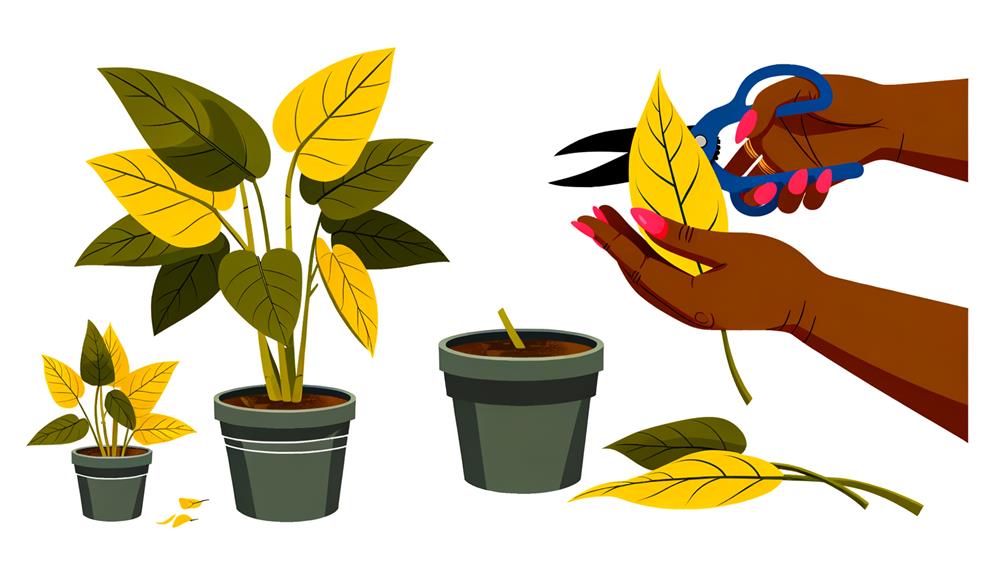
The detailed management of Yellow Philodendron involves not only proper nutrition but also precise pruning and suitable repotting. Knowledge of essential pruning techniques, ideal repotting periods, and post-pruning care is crucial to maintain the plant's health and aesthetics.
In the subsequent discussion, we will explore these aspects in detail, providing scientifically backed guidance for best plant care.
Essential Pruning Techniques
Mastering essential pruning techniques for a yellow philodendron not only enhances the plant's aesthetic but also promotes its overall health and well-being. Pruning yellow philodendron requires precision, knowledge, and an understanding of the plant's growth pattern.
Selective Pruning: Begin by identifying dead or yellowing leaves. These are often a sign of overwatering or lack of sunlight. Carefully remove these leaves at the base to avoid damaging the main stem.
Thinning: If your philodendron is overly dense, selective removal of some healthy leaves can increase airflow and reduce the risk of disease. Always make clean cuts with sterilized tools.
Shaping: Prune strategically to guide the plant's shape. Regular trimming will create a fuller, more balanced appearance. Remember, each cut encourages new growth in that direction.
Optimal Repotting Periods
Understanding the ideal repotting periods for yellow philodendrons is crucial for maintaining their health and promoting robust growth. Generally, the best repotting period is during the spring, when the plant is in its active growing phase. This timing allows the plant to recover swiftly from the stress of repotting, leveraging the season's favorable growth conditions.
However, it's not solely about timing; proper pot size and soil selection are also key. A larger pot encourages root expansion, and a well-draining, nutrient-rich soil fosters healthy growth.
Repotting should be done with care to avoid damaging the root system. It's a delicate process requiring patience and precision, which, when performed correctly, greatly benefits the plant's overall health and strength.
Post-Pruning Care Tips
After a successful pruning session, following a series of post-pruning care tips is important to guarantee your yellow philodendron recovers swiftly and continues to thrive.
- Watering: Make sure the plant receives adequate watering post-pruning. However, avoid overwatering as it can lead to root rot. Maintain a balanced watering schedule that keeps the soil moist, but not soggy.
- Lighting: Position your philodendron in a spot where it receives bright, indirect light. Direct sunlight can cause leaf burn, especially on freshly pruned surfaces.
- Fertilizing: Apply a balanced houseplant fertilizer to provide essential nutrients that support recovery and new growth. It's advisable to dilute the fertilizer to half the recommended strength to avoid overwhelming the plant.
Dealing With Common Pests and Diseases
In the domain of yellow philodendron care, combating common pests and diseases forms a crucial chapter. It requires a thorough understanding of the potential threats and the most effective response strategies.
Mealybugs, aphids, and spider mites pose significant challenges, often leading to reduced plant vigor and discolored leaves. A well-directed application of insecticidal soap or neem oil can effectively manage these pests.
Additionally, fungal infections such as root rot can be prevented by ensuring proper drainage and avoiding overwatering. For bacterial leaf spot, remove the infected leaves and apply a suitable bactericide.
Conclusion
To sum up, the careful cultivation of Yellow Philodendrons necessitates a harmonious balance of ideal indoor or outdoor placement, appropriate watering, suitable soil, regulated temperature and humidity, judicious fertilization, timely pruning, and diligent pest control.
Much like a symphony, each element plays its role to create a masterpiece. Failure in any one aspect can disrupt the delicate balance, leading to compromised plant health. Therefore, meticulous attention to each detail is crucial for fostering a thriving Yellow Philodendron.

